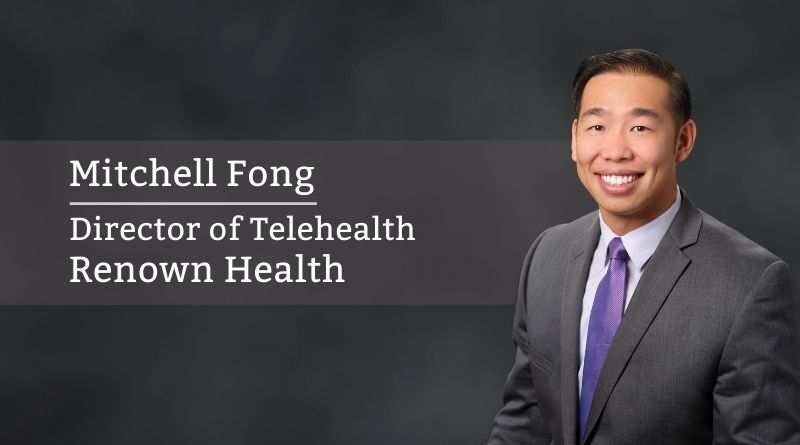INCREASING ACCESS TO HEALTHCARE, TELEMEDICINE DESTINED FOR GREATNESS
By Mitchell Fong, Director of Telehealth, Renown Health
Since embarking on my graduate research study on Telehealth in 2011, I have dedicated my career to expanding telehealth services in both urban and rural areas of Nevada and California. This has been an enriching journey, and I cannot imagine a more exciting time to be in the field of telehealth.
OVERCOMING THE STIGMA
The biggest challenge we seem to run into in telehealth is the stigma that patients and providers may associate with. Many believe the quality of care is reduced if delivered virtually. Luckily, that stigma is beginning to shift with more research and exposure on the effectiveness of telehealth to deliver high-quality healthcare. Patients are beginning to see the unmatched value telehealth affords them, as it allows access to top-notch care when and where they need it.
The COVID-19 pandemic has been a major disrupter that has pushed telemedicine at least three to five years ahead of its previously estimated trajectory.
CARING FOR UNDERSERVED POPULATIONS
Telehealth has been critical in delivering care not only to urban settings but to underserved communities as well. These areas may struggle to recruit and retain physicians because they are low income or less populated, making it difficult to sustain a successful practice. Leveraging telehealth has been an instrumental way to extend healthcare to communities like these. Telehealth can also help augment existing services by providing physician support to reduce isolation and increase access to a peer network for referrals and second opinions. Underserved populations that may benefit significantly from telehealth include tribal health communities, departments of corrections, and areas designated as healthcare provider shortage areas.
For example, we work with one healthcare system that has minimal access to specialty care providers. Therefore, we set out to create a partnership to offer them telehealth services in specialty care areas such as cardiology, nephrology, and rheumatology. Now, instead of driving a few hours into the city to be seen by a provider, patients can go to a local facility, get the information presented by a healthcare professional, and be seen by one of our specialists without having to travel.
PHYSICIAN CHAMPIONS ON YOUR SIDE
Of course, finding providers interested in telehealth is critical to expanding the field of telemedicine. Providers who understand telemedicine and treat it the same way they treat in-person office visits, and those who are willing to learn new forms of technology, are the physician champions you need on your side. The ideal physician champions will continue to challenge their peers on quality, be the ultimate advocate for their patients, and drive continuous process improvement.
The long-term success of telehealth is dependent on our providers’ ability to provide meaningful feedback, as well as invest time to make sure it meets their clinical needs. In turn, it is our job to listen and evolve with them and offer support every step of the way. We look for providers who are willing to work on their webside manner to ensure a seamless patient experience. Through various educational tools, we teach our providers proper online etiquette when going in front of a camera to offer telemedicine. Our goal is to make patients feel like they are in the same room as their provider despite being miles apart.
NAVIGATING TELEHEALTH AMID THE COVID-19 PANDEMIC AND BEYOND
The COVID-19 pandemic has been a major disrupter that has pushed telemedicine at least three to five years ahead of its previously estimated trajectory. So much so that if your health system does not offer virtual services by the end of 2021 – at the latest – there’s a chance you could be phased out of healthcare.
One of the positives that has come out of this pandemic is the willingness for more patients and providers to try telehealth, thanks to successful outcomes and experiences. Telehealth has increased access to quality care while limiting exposure and supporting physical distancing guidelines. The pandemic has been instrumental in driving regulatory change across the nation to validate the impact and importance of telehealth.
Before COVID-19, I know many providers who would never even consider offering telehealth. Fast forward to today, and they never want to work without it. It is powerful hearing these contrasting viewpoints just a few months apart—a testament to the ever-changing times we live in.
Looking to the future, I predict the term telehealth will go away, as virtual services will no longer be labeled under their own category. When people think of healthcare, they will automatically associate it with all the in-person and virtual care options they have available at all times. I foresee all service lines will be available with a virtual component, and telehealth will become completely integrated into modern-day healthcare.
Until that day, and as telehealth continues to evolve, quicker now than ever, we see an influx in tech companies getting into healthcare with virtual medicine being at the forefront. My advice to you? No matter how unconventional an idea may seem, always be open to learn more and explore the latest innovations in the field. When presenting new ideas, you will likely receive some pushback from your providers, leadership and community, as change can be difficult for everyone, especially if the shift disturbs the usual way of doing things. Remember the best endeavors are often those that require some convincing. You will face challenges and setbacks; however, helping patients receive convenient, streamlined access to the care they need and deserve makes it all worth it. I challenge each of us to be the change we want for our patients today, tomorrow, and into the future.



